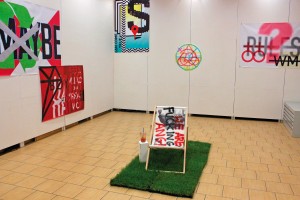I perceive my work as activities on the border of art and design. Two parts of my degree piece define two ways of my search. Generation Y is s subjective portrait of the generation born in the 1980s and 1990s. A series of pieces is centred around social and cultural phenomena that describe this generation and uses the medium of collage as the dominant category of modernity. The project for The Book of One Thousand and One Nights consists in a series of images that refer to Arabic art ornaments, constructed using polyhedral kaleidoscopes. They utilise motifs of naked bodies, applied arts objects, floral, animal and architectural elements. They enter interactions that evoke fairytale mood, and at the same time refer to attitudes towards body and sexuality in European and Middle Eastern culture.

How come Iga Alberska came from her initial inspiration with Zofia Kulik’s photographic compositions to an extensive, both in terms of scale and formal, purely technical complexity, extremely noble and clear expression, so different from to-date tradition of interpretation of One Thousand and One Nights?
We are all familiar with Persian miniatures (aren’t we?), most of us have seen various versions of those; books, comic strips, video games, especially blood-dripping Prince of Persia, various forms of the story of Scheherazade, who avoided the tragic fate of her predecessors from the bedroom of the cruel sultan, for a thousand and one nights telling her made-up stories till dawn.
We all know also extremely rich Arabic ornamentation, based on various geometries, mostly one- and two-axis composition systems. Extremely decorative, carefully avoiding direct reference to living beings.
So stories of Ida-Scheherazade, passionate, dizzying pictures, sometimes full of deep eroticism, are hatched in between ornamentation, despite superficial similarity to arabesque, and violation of canons, not only Koran, but also Judaic and Christian ones.
How were they created, where is the magic and light of shiny diamonds coming from?
There is no fraud in these beautiful pictures. Computer and digital camera were only used to save real and at the same time delicate and ephemeral images created by the artist.
What we can see at odd pages of the great book of the thousand and one nights, was created in kaleidoscopes, huge when compared to toy ones. For the purpose of her degree project Iga Alberska built five- and six-sided kaleidoscopes, more than a metre long. The fact that the images captured in photographs actually existed in reality, makes it a bit of Laocoӧn group’s peep-show combined with kaleidoscope. Anyone who has ever played with kaleidoscope knows that even the slightest movement of the magic telescope changes the image in all mirror reflections at the same time; a cascade of views, centred somewhere in the pupil of the eye of the viewer. Kaleidoscopic images frozen in photography let the reader, or rather viewer, analyse picture piece by piece, with indiscretion of a voyeur; look for sources of reflections and multi-axis symmetry, light reflections and fragments of photographs of naked lovers.
Truthfulness and credibility of these images is heightened by all minor imperfections, like mirror joints, tiny nicks of edges, defocus or image blurs here and there.
While we flip the pages of the dream book, page after page, from black and white, the world from Scheherazade’s stories becomes filled with colour and eroticism, to vertigo.
Words of stories told by Scheherazade can be found in a separate, small book, economical in form, almost like a prayer book designed for a love service. These are the words whispered into the sultan’s ear, sparking his imagination, encouraging to flipping pages on and on.
There is a little, really tiny surprise for enthusiasts of newer media. The spine of the book hides a miniSD card with an audiobook.
Iga Alberska’s degree piece is a beautiful and fascinating work, brand new, insightful interpretation of a work known for centuries, an interpretation that does not come down to literality and avoids vulgarity. Congratulations on a beautiful degree piece, great in every sense of the word.
Finis coronat opus.
Professor Maciej Buszewicz
Iga Alberska’s project is titled Generation Y. This topic is related to collective and individual experience of the generation of transition. Generation “Y” has received the gift of freedom, but also experienced such phenomena as commercialisation, ruthless competition, alienation and exclusion, inability to cope with excessive aspirations and expectations. Iga Alberska does not provide explicit messages. She introduces the viewer to the space filled with sets of pieces, with working names of totem, Ophelia, banners, deckchair, mobile, mirror. She well constructed an installation combining elements of graphic design with real objects and video screening. The resulting work is characterised by high intensity, formal wealth and strong artistic message, addressing a significant issue. I should emphasise that the author put a lot of effort, consistency and very good theoretical background into execution of the degree series. The degree piece received the Rector’s award.
Professor Andrzej Węcławski
B. 1989; studies at the Faculty of Graphic Arts of the Academy of Fine Arts in Warsaw in the years 2009–2014. Study stay at Hochschule für Grafik und Buchkunst in Leipzig under the Erasmus programme, 2012/2013, and work placement in Realgestalt agency, Berlin 2013. She works in fine art printmaking and graphic design.














